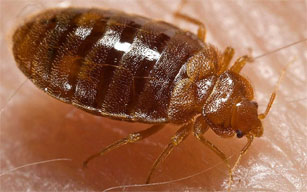
No one wants bed bugs in their home. They are difficult to get rid of and cause annoying, itchy welts. However, bed bugs do not transmit diseases, so they are not considered a public health threat. That's why renters who believe they may have bedbugs should contact their local building department, and not the health department.
Renters who have been unsuccessful in resolving a bed bug infestation with their landlord and/or their local building department can reach out to CLUSTER at 963-6440 to arrange for mediation services. Residents can also contact Legal Services of the Hudson Valley at 949-1305 to see if they qualify for free legal counseling or representation.
Bedbugs can hide in upholstery, and they can enter your home on your suitcases or clothing. Beware of upholstered furniture or beds left curbside for the same reason. Some entomologists even recommend that when you buy new clothes, underwear, socks, sheets or towels, you run them through a hot clothes dryer for 20 minutes, to kill any bed bug eggs that could be hiding there. They can be also be found on wooden slats, springs as well as the bed frame. They can also live in wallpaper crevices, electrical wall plates, light fixtures, wall hangings, cabinetry as well as carpet fibers and wooden floorboards. For their size, common household bed bugs are extremely fast.
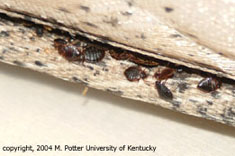 Telltale signs of bedbug infestations are dark spotting and staining, which is the dried excrement of the bugs. Also present will be eggs and eggshells, molted skin of maturing nymphs, and the bugs themselves. Another likely sign of bed bugs is rusty or reddish spots of blood on bed sheets or mattresses.
Telltale signs of bedbug infestations are dark spotting and staining, which is the dried excrement of the bugs. Also present will be eggs and eggshells, molted skin of maturing nymphs, and the bugs themselves. Another likely sign of bed bugs is rusty or reddish spots of blood on bed sheets or mattresses.
Bed bugs prefer to hide close to where they feed. However if necessary, they will crawl more than 100 feet to obtain a blood meal. Initial infestations tend to be around beds, but the bugs eventually may become scattered throughout a room, occupying any crevice or protected location. They also can spread to adjacent rooms or apartments.
Bites and Concerns
Bed bugs usually bite people at night while they are sleeping. They feed by piercing the skin with an elongated break through which they 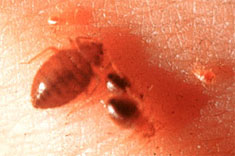 withdraw blood. Engorgement takes about three to 10 minutes, yet the person seldom knows they are being bitten. Some people develop an itchy welt or localized swelling, while others have little or no reaction. Unlike flea bites that occur mainly around the ankles, bed bugs feed on any bare skin exposed while sleeping (face, neck, shoulder, arms, hands, etc.) The welts and itching are often attributed to other causes such as mosquitoes. For these reasons, bed bug infestations can grow and go undetected for a long time before being noticed.
withdraw blood. Engorgement takes about three to 10 minutes, yet the person seldom knows they are being bitten. Some people develop an itchy welt or localized swelling, while others have little or no reaction. Unlike flea bites that occur mainly around the ankles, bed bugs feed on any bare skin exposed while sleeping (face, neck, shoulder, arms, hands, etc.) The welts and itching are often attributed to other causes such as mosquitoes. For these reasons, bed bug infestations can grow and go undetected for a long time before being noticed.
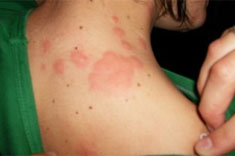
How Infestations Originate
The bugs are efficient hitchhikers and are usually transported in on luggage, clothing, mattresses and furniture. This is a problem for hotels, motels, and apartments, where turnover of occupants is constant. Bed bugs are small, escaping detection after crawling into suitcases, boxes, and belongings. The eggs are almost impossible to see when laid on most surfaces. Purchase or rental of secondhand mattresses, box springs, and furniture is another way that the bugs are transported into non-infested dwellings.
Once bed bugs are introduced, they often spread room to room throughout a building. The level of cleanliness has little to do with most bed bug infestations. Pristine homes, hotels, and apartments have plenty of hiding places and an abundance of warm-blooded hosts.
Controlling Infestations Bed bugs are challenging pests to control. They hide in many tiny places, so inspections and treatments must be thorough. In most cases, it will be prudent to enlist the services of a professional pest control firm. Experienced companies know where to look for bed bugs, and have an assortment of management tools at their disposal. Owners and occupants must remove excess clutter, and in some cases infested mattresses and box springs. Since bed bugs can move from room to room, it may be necessary to inspect adjoining rooms and apartments.
Bed bugs are challenging pests to control. They hide in many tiny places, so inspections and treatments must be thorough. In most cases, it will be prudent to enlist the services of a professional pest control firm. Experienced companies know where to look for bed bugs, and have an assortment of management tools at their disposal. Owners and occupants must remove excess clutter, and in some cases infested mattresses and box springs. Since bed bugs can move from room to room, it may be necessary to inspect adjoining rooms and apartments.
Where They Hide
Bed bugs can live in almost any crevice or protected location. The most common place to find them is the bed. Bed bugs often hide within seams, tufts, and crevices of the mattress, box spring, bed frame and headboard.
A thorough inspection requires dismantling the bed and standing the components on edge. Things to look for are the bugs themselves, and the light-brown, molted skins of the nymphs. Dark spots of dried bed bug excrement are often present along mattress seams or wherever the bugs have resided. Oftentimes the gauze fabric underlying the box spring must be removed to gain access for inspection and possible treatment. Bed bugs also hide among items stored under beds.
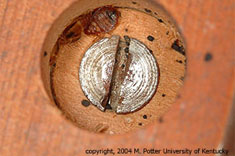 Many areas besides beds, however, can harbor bed bugs. Nightstands and dressers should be emptied and examined inside and out, then tipped over to inspect the woodwork underneath. Oftentimes the bugs will be hiding in cracks, corners, and recesses. Upholstered chairs and sofas should be checked, especially seams, tufts, skirts, and crevices beneath cushions. Sofas can be major bed bug hot spots when used for sleeping.
Many areas besides beds, however, can harbor bed bugs. Nightstands and dressers should be emptied and examined inside and out, then tipped over to inspect the woodwork underneath. Oftentimes the bugs will be hiding in cracks, corners, and recesses. Upholstered chairs and sofas should be checked, especially seams, tufts, skirts, and crevices beneath cushions. Sofas can be major bed bug hot spots when used for sleeping.
Treatment Procedures
It often takes hours to properly inspect and treat a bed bug infestation. Follow-up visits are usually required and owners/occupants have important pre-treatment responsibilities.
- Reduce clutter. Belongings strewn about rooms afford many places for bed bugs to hide, and impedes inspection and treatment.
- Infested bedding and garments must be bagged and laundered (120 degrees F minimum) or discarded since these items cannot be treated with insecticides. Professionals sometimes use high heat blowers to kill off bed bugs and their eggs.
- Smaller items that cannot be laundered can sometimes be de-infested by heating. Individual items, for example, can be wrapped in plastic and placed in a hot, sunny location for at least a few days (the 120 degree F minimum target temperature should be monitored in the center-most location with a thermometer).
- Bed bugs also succumb to cold temperatures below 32 degrees F, but the chilling period must be maintained for at least two weeks.
- Remove bugs and eggs from mattresses, carpet, walls and other surfaces by vacuuming. Pay particular attention to seams, tufts and edges of mattresses and box springs, and the perimeter edge of wall-to-wall carpets. Then, dispose of the vacuum bag and its contents in a sealed trash bag.
- Steam clean your carpets to kill bugs and eggs that vacuuming may have missed.
Brochures
- Preventing and Getting Rid of Bed Bugs Safely (NYCDOH)
- Bed Bug Control (Integrated Pest Management, Cornell Cooperative Extension)
- Chinches Domesticas (Texas Cooperative Extension)
Other Resources
